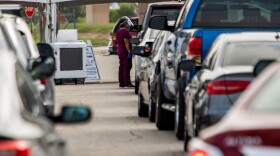With average daily hospitalizations in the Austin metro area ticking above a key threshold of 70 per day Tuesday, public health officials are weighing whether to recommend the region move to stage 5 of their “risk-based guidelines.” The guidelines at that stage call for closing all but essential workplaces and having even low-risk individuals avoid gatherings outside the household.
The City of Austin lacks the authority to order an economic shutdown similar to the one the state mandated in March, but city staff are reviewing what powers they can exercise under Gov. Greg Abbott’s executive orders.
Public health officials, meanwhile, are asking people to return to shelter-in-place behaviors from three months ago to help slow the spread of the coronavirus before it overwhelms the health care system.
“We want you to go back to those days,” Austin Public Health Director Stephanie Hayden said during a news briefing Wednesday. “Only go out when it’s absolutely necessary.”
Hospital Admissions
Austin Public Health officials on Tuesday changed how they calculate the number of average daily hospitalizations of COVID-19 patients in the Austin metro area. That seven-day moving average was adjusted to include people who tested positive for coronavirus after the day they were admitted to a hospital. The inclusion of those patients caused a jump in the average to 74.9 from 64.6 the day before.
The city has said the threshold for entering stage 5 is above 70, but at Wednesday's briefing, interim health authority Dr. Mark Escott said it could be as high as 123, depending on how sharply the average number of new admissions is rising.
Local health officials will be meeting with leaders from hospital systems and a disease-modeling team from UT to determine if they should move the region into that highest level of restrictions.
“We are in a very dangerous situation in the state of Texas,” Escott said. “We simply must be careful, because we are at the verge of a real crisis in Texas.”
The Austin Convention Center is being prepared to serve as a field hospital and should be ready by July 20, Escott said. The biggest “pinch point” for getting that ready is finding enough people to staff it.
Testing Wait Times
As infections in the Austin area have soared, the increased demand for testing means it’s taking longer for people to find out if they test positive.
At Wednesday's briefing, Escott said a lot depends on who administers a test and which lab processes the sample. A lab called AIT delivers results in about two days, he said, and results are automatically sent by email or text.
Major national labs like Quest and LabCorps can take seven to 10 days to return test results, he said. In one instance, it took 11 days for a person to get results.
“At that stage, the test results are relatively useless for us,” Escott said, “because the purpose of the testing is to identify the contacts, to isolate the positive person [and] get their contacts tested to box it in.”
This story has been updated.
Got a tip? Email Nathan Bernier at nbernier@kut.org. Follow him on Twitter @KUTnathan.
If you found the reporting above valuable, please consider making a donation to support it. Your gift pays for everything you find on KUT.org. Thanks for donating today.





